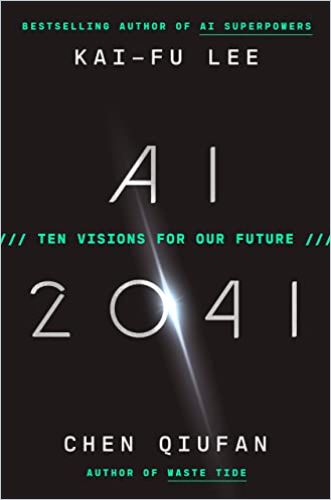Best-selling AI expert Kai-Fu Lee and speculative fiction author Chen Qiufan consider the AI of 2041 through hard-nosed analysis and illuminating tales.

The Future of AI
AI expert Kai-Fu Lee – author of the best-selling AI Superpowers – and Chen Qiufan – author of The Algorithms for Life – envision what AI and its place in human society might be like in 2041. Alternating between stories that involve AI and nonfiction analyses, the authors prove themselves to be optimists. They speculate that AI may reduce human poverty, dramatically improve health care and enable more people to lead meaningful lives.
Deep AI
Deep learning can, for example, provide precisely tailored health advice, but raises problems. Since available data drive it, AI can reproduce a society’s prejudices, such as racism. Deep learning AI programming works through layers of neural networks that mimic the human brain’s functioning while maximizing a specified aim. Humans can train AI to determine, for example, whether a person is likely to develop a health problem – and set insurance premiums accordingly.
Deep learning is a recent AI breakthrough. Among the many subfields of AI, machine learning is the field that has produced the most successful applications, and within machine learning, the biggest advance is deep learning.Kai-Fu Lee and Chen Qiufan
AI can synthesize vast amounts of data simultaneously, but lacks common sense. Because the AI brain requires a narrow aim for its algorithms to gain traction, it encourages limited thinking.
Deepfakes rely on computer vision, which requires complex capabilities. The computer must be capable of harnessing and processing images, identifying and recognizing objects, tracking and recognizing objects’ movements, and understanding the relationship between objects in a scene. Computer vision capabilities appear in autonomous cars drones and facial recognition software. Deepfakes require something greater.
Creators make deepfakes with generative adversarial networks (GANs), in which one network synthesizes the images or video and the other network probes its authenticity. This results in a fake video that deceives human vision and judgment. Deepfakes will create serious problems for governments and businesses. By 2041, the authors predict “anti-deepfake software” that serves a similar purpose antivirus software serves today.
Health Care
COVID-19 hurled digitization in health care and other areas into overdrive. Digitization demands data collection – and fuels more efficient and accurate AI. Health care may be on the cusp of a revolution. Health care researchers focus on how massive databases of digitized patient records can be harnessed for drug and vaccine development and “precision medicine.”
COVID-19 will be remembered not just as a pandemic, but as an automation-accelerating event.Kai-Fu Lee and Chen Qiufan
Scientists developed vaccines for COVID-19 at unprecedented speed, largely due to massive government investment. AI will speed the development of vaccines and other drugs and might reduce exorbitant development costs. As AI proves an increasing factor in health care, huge amounts of digitized information will become available for each patient. Relying on that data, doctors can formulate customized treatments that enable people to live longer, more healthy lives.
Ethical and Legal Issues
AI-driven autonomous vehicles deploy neural networks instead of a brain and an array of mechanical parts, such as cameras and radar, instead of human hands, feet and eyes. The transition from human drivers to fully autonomous vehicles will happen in stages. A human can drive while AI scans the road and provides alerts. Or, AI can perform a single or multiple driving tasks. Or, AI can do the driving as the human stays ready to take over in case of an emergency. The principal obstacle to a fully autonomous vehicle is the difficulty of training the AI to respond to all possible driving circumstances. The data would be immense, and collection methods remain murky.
When sufficiently developed, fully autonomous vehicles will radically transform transportation. “On-demand cars” will get you where you want to go when you want to go there, more safely and cheaply than human-driven vehicles. But fully autonomous vehicles pose ethical and legal issues. For example, the AI must have the capability to make complex ethical choices, such as choosing between the evils of striking one person or several, depending on which would keep vehicles’ human passengers safer. When an autonomous vehicle causes a fatality, who is responsible?
The first two revolutions in warfare were the invention of gunpowder and the creation of nuclear bombs. The third revolution is AI-driven autonomous weapons. A fully autonomous weapon tracks down and finds a target, destroying it without any direct human involvement. The Israeli Harpy drone, for example, searches for targets in a specific area and destroys them. So-called “slaughterbots,” small drones that seek out individuals and shoot explosives through their skulls, raise even more complex moral and political issues. A person with reasonable skills could make these small drones for $1,000 out of commonly available materials.
Autonomous weapons, or “killer robots,” will become faster, more precise and cheaper to make. Autonomous weapons will save soldiers’ lives and, deployed responsibly, will focus on combatant targets to avoid civilian casualties. Ethical objections to autonomous weapons far outweigh their benefits. Delegating killing human beings to machines eases the path to killing. And should an autonomous weapon makes a mistake, no one is accountable.
AI will put countless people out of work, factory workers, accountants and insurance brokers alike. Mass unemployment may exacerbate economic and social inequality while enriching those running technology companies.
What exactly are the new jobs – and will they satisfy many humans’ desire to feel productive and useful? Who is most at risk, and how can humans flourish in the post-automation era?Kai-Fu Lee and Chen Qiufan
Society must reconfigure old jobs and generate new ones. The authors hold out for the possibility of an AI-inspired creative renaissance in which people revere “creativity, compassion and humanity.”
Human Conjecture
Lee and Qiufan offer fully human, completely undigitized conjecture about the future of AI. By alternating between Qiufan’s speculative, metaphorical fiction and Lee’s rigorous speculative analysis, the authors offer what AI cannot – emotional consideration of likely facts and imaginative interpretations when no facts are available. This makes their work readable, fascinating and thought-provoking. When you’ve had sufficient fiction, Lee provides a reasoned, likely future. When you prefer the joys of a made-up future, Qiufan carries you away into sci-fi with a compelling teaching component. The authors consider the available data and use it for the most ancient human task – turning information into narrative.












